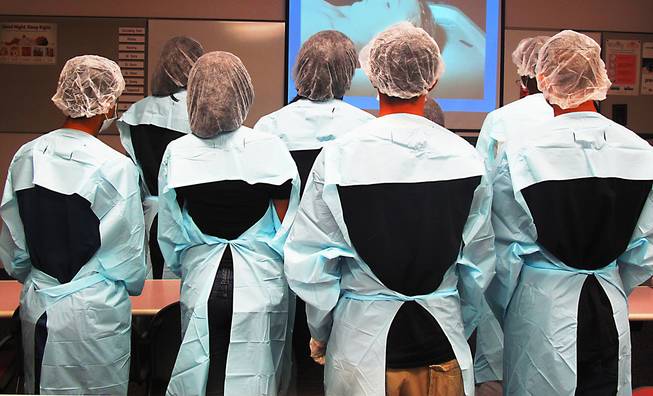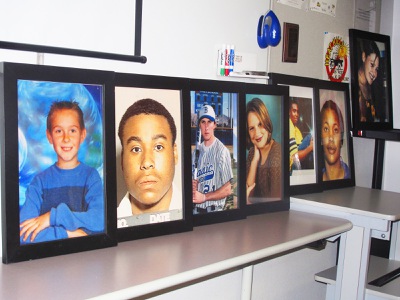
Before a behind-the-scenes tour of the coroner's office, teens look at an image of a dead Las Vegas teen.
Tuesday, Oct. 5, 2010 | 2 a.m.
It’s 6 p.m. at the Clark County coroner’s office and the building is eerily quiet, except for 15 teenagers finding seats in a classroom.
“This is a scary building,” instructor Ron Moracco tells the teens, who all have arrests for violent behavior. “The whole time it’s silent.”
No sirens or flashing lights. The white vans that pull up to this building carry people whose lives are over. As he’s talking, Moracco notes that four vans have arrived this evening — four names to be added to the list of deaths for the day in Clark County.
The teens are gathered this evening for the Coroner’s Visitation Program, a court-ordered class for youths who have demonstrated violent or reckless behavior. The program seeks to deter future criminal activity. Since its start in March 2002, about 7,500 students have gone through the three-hour sessions, which include seeing dead bodies, as one student points out at the beginning of the class.
As Moracco commands the teens’ attention, he sets the record straight: “We want you to understand you’re not being sent here as a punishment.”
After all, they are all familiar with punishment. Some landed in the juvenile detention center. Others received probation. More were told they’re dangerously close to being “certified” — meaning tried as an adult for any future crimes. That’s because some of these youths, including a 13-year-old, have been arrested for violent behavior, classified as actions with an intended victim.
Armed home invasions. Domestic violence. Gun charges. Selling drugs. Stealing cars. Obstructing an officer. Robbery.
“When you leave here, what you do with this information is going to be up to you,” Moracco says. “We’re not going to scream and holler at you.”
Moracco, a retired teacher, works with program coordinator Roy Chandler and fellow instructor John Struzik to teach the program, the first of its kind in the country.
At its core, the program is about making choices. Instructors use true stories of Las Vegas teens to illustrate stark consequences.
“Either you’ll get killed or go to jail,” Chandler says matter-of-factly.
A row of framed pictures sits at the front of the classroom. Each person pictured, mostly teens and young adults, is dead.
“We want to keep you out of jail,” Chandler says. “That’s what we want for all of you. I don’t want to see you come to the back door here as a body.”
Of about 10,000 bodies that arrived here last year, 372 were under 18. That means an average of one teen in the Las Vegas Valley dies each day. Causes of death range from violent or reckless behavior to illness.
Take 18-year-old Chay, for example. During a botched home burglary attempt, the homeowner shot and killed him. His accomplice, Laron, fled the house but is serving a life sentence because of the felony murder law.
“If you’re in the process of (committing) a felony and someone dies, you’re charged with murder even if you don’t have a weapon,” Chandler informs the class.
Then there’s 18-year-old Christina, a former Mojave High School student, who died after drinking alcohol and smoking marijuana. She and a friend were making a truck spin doughnuts in a desert area. The truck flipped. Detectives found pieces of her brain matter on the ground.
Or 13-year-old Jesse, who joined a gang to avoid being bullied. He was killed during a drive-by shooting. His supposed new protectors were nowhere in sight.
“That’s sad. He looks so young,” a 16-year-old girl in the program says as she looks at a picture of Jesse soaked in blood.
At one point, Chandler poses a question, one he says he already knows how the 15 teens will answer.
“Who’s in a gang?” he says.
No one raises a hand.
“Who runs with the gangs?”
Only one student raises her hand, clarifying that she knows people in gangs.
Despite the teens’ denials of gang involvement, the program coordinator and instructors suspect otherwise. During the program, many students seem familiar with gang initiations and symbols.
That’s why the Southern Nevada Community Gang Task Force — an umbrella organization that brings together community and law enforcement agencies to prevent gang activity — considers the Coroner’s Visitation Program a key part of its intervention strategy.
Jerry Simon, gang specialist for the Clark County Juvenile Justice Services Department, has operated the gang task force since assuming his position in 2001. He says teens involved in gangs who attend the Coroner’s Visitation Program have an 8.5 percent recidivism rate, meaning they’re less likely to repeat their crimes. That’s the lowest recidivism rate among similar rehabilitation programs, he says.
“This is where their heads are finally open, and we can put something in it,” Simon says.
Overall, the program boasts a 12.6 percent recidivism rate, which includes teens with and without gang affiliations, Chandler says. The national recidivism rate for rehabilitation programs is 46 percent, he says.
Of course, not all teens enter the class ready and willing to change their lifestyle.
Toward the beginning of the program, Chandler explains that the public doesn’t have much sympathy for their mistakes. Many people, he says, “want to beat you up and kill you.”
A teen convicted of an armed home invasion claims it’s not going to happen to him.
But others have died, Chandler replies, as some in the class snicker at the teen’s statement.
For 31 years, Chandler saw the grim results of violence. He worked in Metro Police’s homicide unit from 1970 to 2001 and didn’t hesitate to help develop the Coroner’s Visitation Program when approached by former Coroner Ron Flud.
A steering committee with representatives from the state Legislature, Clark County commissioners, Eighth Judicial District Court, Las Vegas Justice Court, Youth and Family Services Department and the coroner’s office set the program in motion.
State Sens. Dennis Nolan and Valerie Wiener drafted a bill for the program, which was enacted in 2001. Clark County owns and operates the Coroner’s Visitation Program, paid for by a $45 student registration fee. The program, offered to young adults up to age 22, also requires a referral or court order, proper identification and a parent or guardian at registration.
During the last 45 minutes of the program, the teens change into scrubs — caps, bootees, smocks, surgical masks and gloves — before their behind-the-scenes tour of the coroner’s office.
Inside an office next to the facility’s garage, they scan a whiteboard listing the names of people who died and were brought in during the past two hours. The chart lists eight names, including a 22-year-old who likely died of a drug overdose.
Case No. 7652 is the 7,652nd person who died in Clark County this year, a number typical by this time.
As the group heads to the cooler rooms for storing bodies, the garage door opens and a white van pulls in: The ninth body of the day has arrived.
Several teens clutch their masks as the distinct, potent smell of decaying flesh greets them inside the first cooler room, which is lined with green and white body bags on gurneys.
Chandler unzips a portion of a body bag to give a glimpse.
“I want you to turn and look at these gurneys, and I want you to think how you’re feeling,” he instructs the group. “Now visualize a loved one. Do you want to put your mom through this?”
Most shake their heads.
Next, the group ventures to a smaller cooler room where the stench is even greater and the temperature even lower. It’s a room for all the John and Jane Does awaiting identification — some for years. A skull sits next to a body bag.
“What’s that?” a teen girl says, motioning to a brown spot on a green body bag.
“It’s blood,” Chandler says.
Chandler explains how doctors perform autopsies while in the autopsy room before the group checks out other special rooms, such as a histology room and X-ray room.
At one point, Chandler describes how doctors extract bullets from shooting victims without making any new marks, so the police can match the bullets with any guns retrieved at a crime scene.
In the classroom, the scent of bodies clinging to their clothes, Simon addresses the group.
He knows the choices that lie ahead for them. He was in their situation years ago, but someone stopped him in time.
“If I could change, you think you could change?” he says.
The gang task force, Simon says, has helped 87 teens and young adults escape gangs since 2001.
“We’re here to save your life,” he adds.
As the clock nears 9 p.m., Chandler offers a parting message:
“If we’ve offended you in any way, I’m not going to apologize because it has made you think,” he says.
A 14-year-old student who spent one month in a juvenile detention center for a robbery conviction — and described it as “not somewhere you want to be” — is the last to leave.
“Thank you guys,” he says to the instructors as he leaves the room clutching his certificate of program completion. “Appreciate it. Have a good night.”


Join the Discussion:
Check this out for a full explanation of our conversion to the LiveFyre commenting system and instructions on how to sign up for an account.
Full comments policy